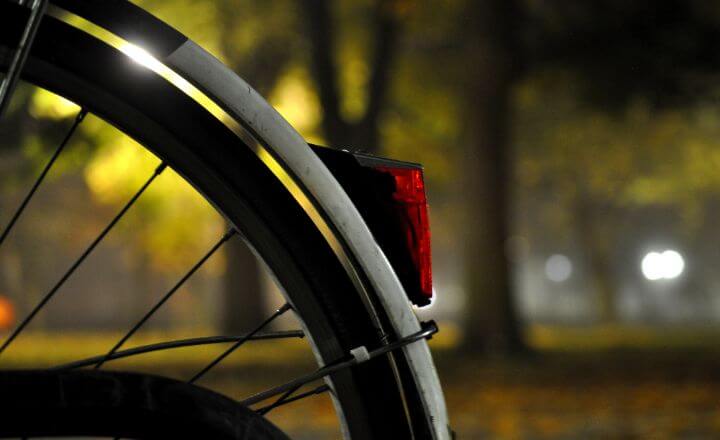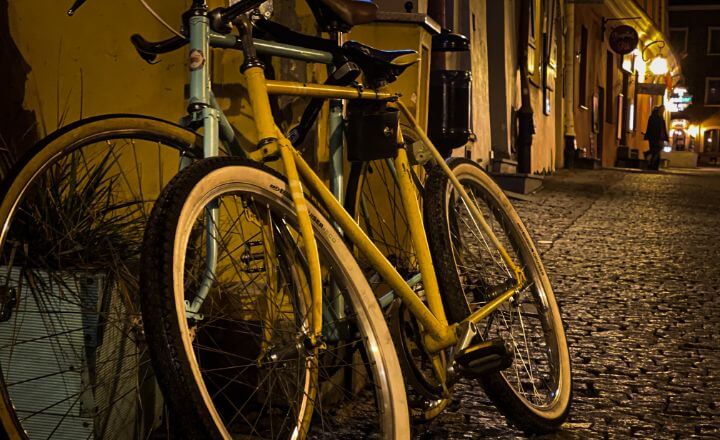(Last updated on April 17th, 2023)
A dynamo bike light is a headlight powered by a mini-generator in the hub of the bike’s wheel. It converts energy created by the spinning wheel into usable electrical energy. That energy powers dynamo headlights and rear lights. The lights are on whenever the bike is in motion without batteries or charging. Dynamo hubs can power USB ports, too.
In the movie, The Hiding Place, you’ll see Polish people pedaling their bikes in the dark, their way lit by bicycle-powered lights. But dynamo bike lights aren’t just old technology – they are resurging in popularity, especially now that ultra-endurance cycling events, bike-packing, and bike touring trips are on the rise.
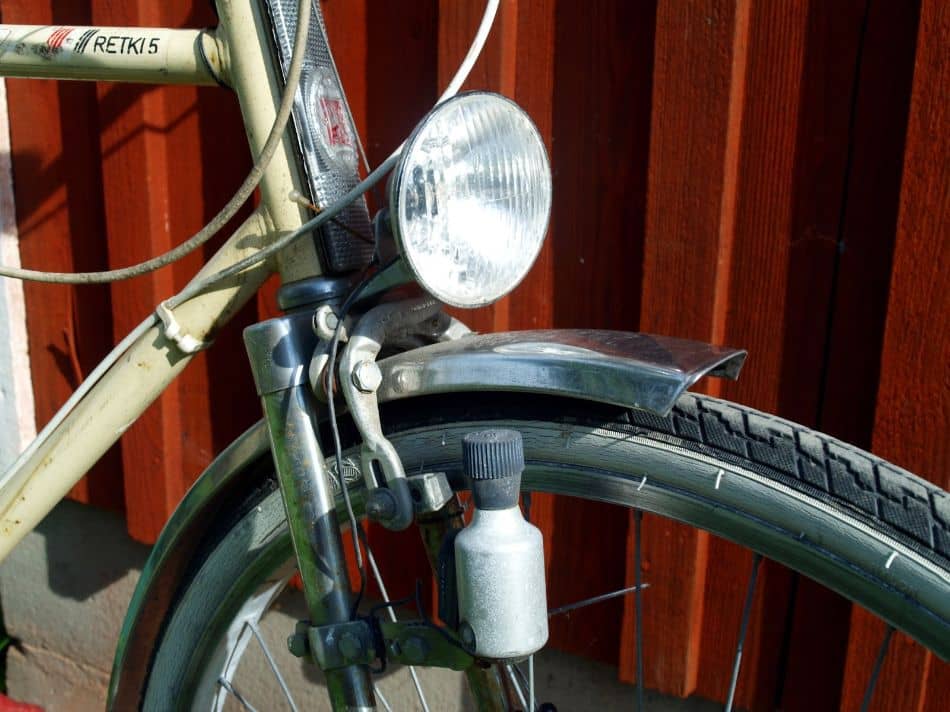
In this article, I’m going to talk about dynamo bike lights. First, I’ll explain what they are and how they work. Then, I’ll discuss the different kinds of dynamos and compare them to other bike lights.
- What is a Dynamo Light?
- Why Haven’t I Heard of Dynamo Bike Lights?
- How Do Dynamo Lights Work?
- Are Dynamo Lights Better than Battery-Powered Lights?
- Do Dynamo Lights Actually Slow You Down?
- Can a Dynamo Hub Charge Other Devices?
- Pros and Cons of Using Dynamo Lights
- Who Benefits from Riding with Dynamo Bike Lights?
- How Do I Install a Dynamo Light on My Bike?
- Final Thoughts on Dynamo Lights
- Frequently Asked Questions
What is a Dynamo Light?
A dynamo is a unique hub built into the front wheel of a bike. The hub generates energy from spinning the wheel to power headlights, taillights, and more. Dynamo lights are sturdy, environmentally friendly, and convenient bike lights that turn on when you ride your bike.
You don’t have to worry about charging up your lights, taking them on and off the bike, or making sure no one steals them. Dynamo lights are permanently installed on your bike and never need to be charged.
Original dynamos were powered by the tire rather than the hub. They resembled small bottles and were mounted to the bicycle’s fork. As the tire turned, it also turned the dynamo, causing it to create energy. As technology advanced, bike component manufacturer Sturmey Archer figured out how to make the dynamo even more efficient. It moved the generator to the inside of the front wheel’s hub. Most modern dynamos are hub-based, although it is possible to find tire-driven models today.
Although hub-driven models are more efficient, tire-driven models are easier to retrofit to existing wheels and disengage.
Why Haven’t I Heard of Dynamo Bike Lights?
In the United States, bicycling is seen as a sport. In other countries, bicycling is seen as a popular means of transportation. So in the United States, bike lights are often an afterthought. So instead, companies create battery-powered lights that can be added to your bike after you’ve purchased it.
Since many of the bikes sold in the US are race bikes, you wouldn’t expect to ride them at night or for commuting. However, many e-bikes that are sold will have built-in lights that run off of the e-bike battery.
In Germany, cycling is much more popular as a mode of transportation. Bikes in Germany and other European countries are created with built-in lighting solutions like dynamo lights. Other countries have more stringent regulations on bike lights, so the dynamo light is an excellent product to meet those requirements.
How Do Dynamo Lights Work?
Dynamo hubs produce electricity using electromagnetic induction. Magnets are embedded into the outside of the hub, and as the wheel spins, they pass over a coil of wire. Technically, you could say that dynamo hubs are more like generator hubs since they produce alternating currents.
The faster you ride, the more power your hub will produce. Typically, dynamo hubs will produce six to twelve volts at a max power of three watts.
Dynamo hubs are created for specific wheel sizes because smaller wheels spin faster than larger wheels at the same speed. So if you’re riding a 20-inch folding bike, you’ll need a different-sized hub than you would for a 700C wheeled bike. Unfortunately, using the wrong size can send too much or too little power to your light, which can cause damage to the light.
Older dynamo lights plugged directly into the hub and used incandescent bulbs, which break easier and aren’t as bright as modern LEDs. However, newer dynamo lights are LED lights. They can convert the AC power to DC and may have over-voltage protection. They may also have a small battery inside (or a capacitor) that keeps the light on long enough to last through traffic lights and stop signs when you are not pedaling.
Once the dynamo light is installed on your bike, you no longer have to think about it. Whenever the bike’s wheel is spinning, the light will stay on. When you pause at a traffic light or stop sign, the light will stay on briefly, although some lights will stay on at half-power.
Once you start moving again, the light will turn on again. You never have to turn them on and off or charge the light. The spinning wheel does that for you.
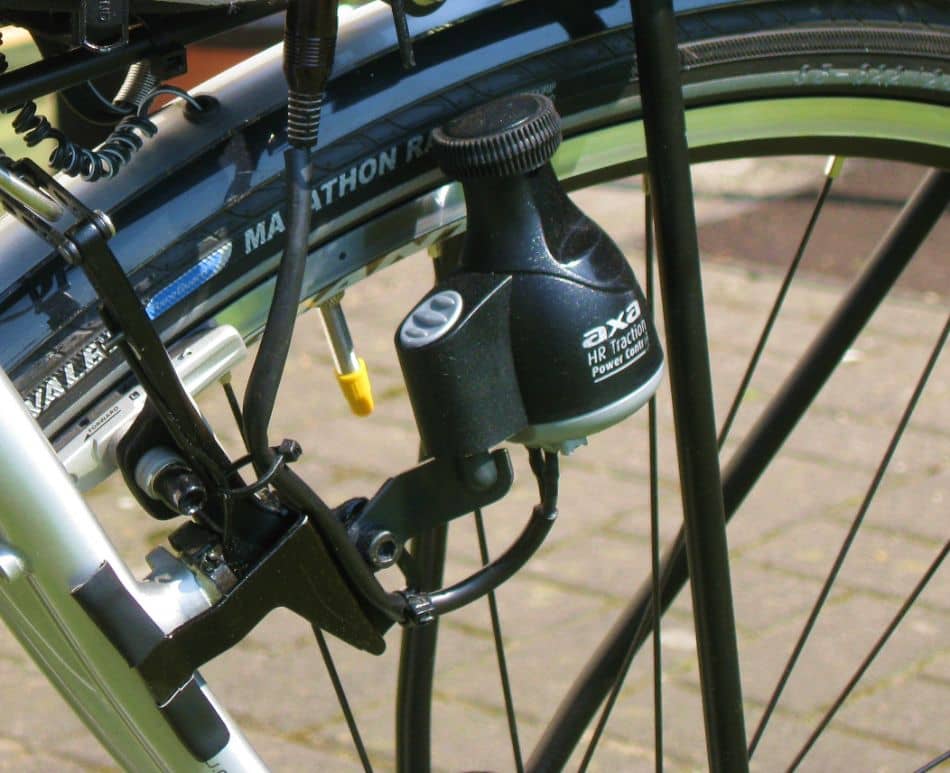
Are Dynamo Lights Better than Battery-Powered Lights?
Dynamo technology has been around for many, many years. As a result, they’re a great choice for certain applications.
For example, dynamo lights work really well for extended riding. Typical, battery-powered bike lights will last up to 5 hours on low power but may only last for an hour or two on high power. But if you are riding at night, you’ll need to use the high-powered beam to give you enough light to keep you safe unless you’re riding in a very well-lit area.
On the other hand, Dynamo lights are always on, and they never run out of power. This is because you create the power to run the lights with your legs. Whenever the wheel spins, the magnets pass over the coil and produce the energy needed to light the light. After you stop riding, the light goes out.
So if you do a lot of riding at night, you don’t want to worry about getting stranded because your battery-powered lights didn’t last long enough. A dynamo will always give you light. You don’t need to worry about forgetting to turn it off to save the battery.
And if you’re like me, I always forget to turn on my taillight when riding. But dynamo taillights are always on whenever you ride. I also forget to turn my taillight off when loading it up on the rack. But you don’t have to worry about that with a dynamo light, either.
In some countries, you must have front and rear bike lights turned on anytime you are riding. In this case, you’re better off using a dynamo because you will always have the needed light.
For this reason, many commuter or daily bikes in Germany are manufactured with dynamo lights already installed.
On the other hand, battery-powered lights are smaller and lighter. So you might prefer this to a built-in dynamo if you only need your lights occasionally or if you need something very lightweight and compact. Battery-powered lights can be attached to your handlebars or even your helmet.
If you are riding off-road, though, you might not want to use a dynamo light. The rough road and bumpy terrain from mountain biking can cause the light to flicker and be inconsistent. Additionally, the shape of the light created from the dynamo light is better geared toward road riding. The dynamo light is created to illuminate the road without blinding oncoming cars, but it may not illuminate enough of the terrain when you are off-roading.
Both types of lights have their place in the cycling world.
Do Dynamo Lights Actually Slow You Down?
Bike racers spend thousands of dollars getting as aerodynamic as possible. And while any accessory on your bike – such as a light, handlebar bag, or even a water bottle- can add to the aerodynamic drag and slow you down, dynamo lights also slow you down.
Magnets power the lights. As the magnets pass by the coil, they create drag. This drag is minimal and may equal about 6 or 8 weights of lost power from your legs. The faster you go, the more watts will be lost. You might not notice the drag on a fun, casual ride or your typical commute to work.
So yes, technically, dynamo lights will slow you down a little bit. But for most people, this isn’t any more drag than you would feel from a dirty bike chain or inefficient drive train.
On the other hand, if you are a serious racer, unless you are racing at night, you won’t have any extra accessories on your bike. And you especially wouldn’t be hardwiring a dynamo light to your race bike.
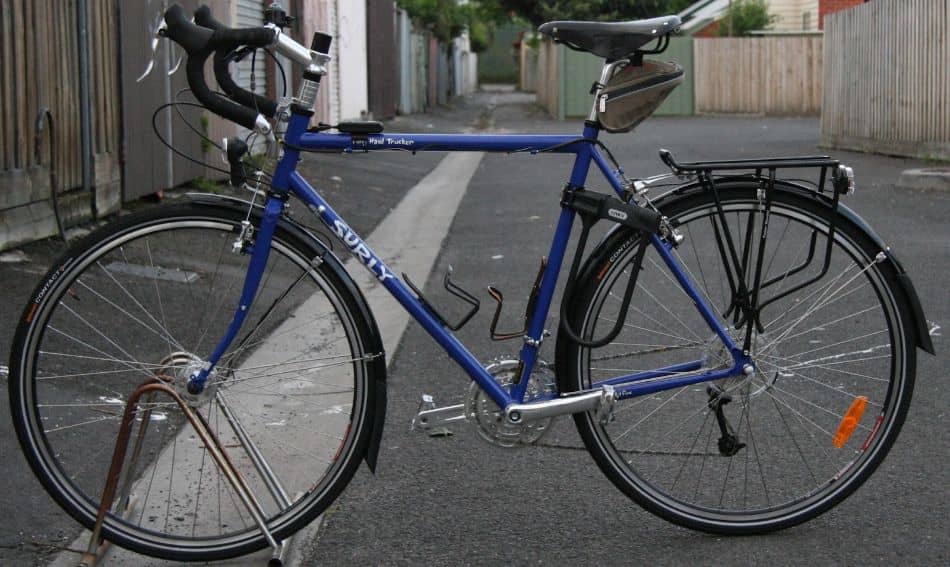
Can a Dynamo Hub Charge Other Devices?
You can use dynamo hubs to charge other devices. However, you may need a convertor, or a rectifier, to change the current from AC to DC. Some brands of dynamo bike lights include USB outputs that you can use to charge your devices.
Remember that you might not be able to get a full charge from your dynamo hub. The max power output from your dynamo is typically around 4 watts. Most slow phone chargers need a minimum of 5 watts. So you may not be able to get enough power to charge or run your phone fully. However, you should be able to charge or at least power your bike computer.
You can create your own DIY USB dynamo charger if you are handy.
Pros and Cons of Using Dynamo Lights
There are many pros and cons to using dynamo lights to help you decide if this type of lighting is good for you.
Pros
Environmentally Friendly
Dynamo lights don’t use batteries, even rechargeable ones. Instead, you generate the light you need while riding, so they are much more sustainable and reduce your environmental impact by removing the need for charging or replacing batteries.
Theft-proof
Because the dynamo lights are somewhat built into your bike frame and wheel, they are much more difficult to steal than a typical clip-on light that you find on many handlebars and seat posts.
Durable
Modern dynamo lights are made with long-lasting LEDs, which are durable and bright.
Convenient
You don’t have to worry about forgetting to charge your light, pack it, or lose it somewhere. Dynamo lights are always on while you’re riding and are always attached to your bike. You don’t have to worry about running out of battery power or bringing extra batteries or lights for long rides. And you won’t have to worry about whether or not you removed the light before loading your bike on your trunk rack.
Safe
Dynamo lights are always on and bright, making it easy for you to see the road and for others to see you.
Reliable
Dynamo bike lights are sealed, so they’ll work even in bad weather. In addition, these lights are reliable, so you don’t have to worry about getting stuck in the dark if your battery-powered light should go bad.
Cons
Aerodynamic Drag and Weight
If you’re a weight weenie or need to save every last watt, you might not really be into dynamo lighting systems. They can be heavy, cause aerodynamic drag, and reduce the watts produced.
Expense
A high-quality dynamo light system isn’t cheap. For example, if you want a hub dynamo, you’ll need a new front wheel with a built-in hub. That, combined with the cost of the lighting and wiring, can add up to a hefty bill.
Cut-off Beam
The beam shape on a dynamo light is created for road riding. It’s meant to illuminate the road well without making it difficult for oncoming traffic to see. Unfortunately, this isn’t an ideal shape for riding off-road or mountain biking at night.
Who Benefits from Riding with Dynamo Bike Lights?
If you live in a country that requires lighting on your bike at all times, you will benefit from using an always-on dynamo system. In Germany, they are standard on most new bikes.
Daily commuters
If you commute by bike daily, you might want a dynamo light because you don’t need to remember to charge it every single day. It’s always there; you won’t forget to charge it or bring it.
Bikepackers or Biketourers
If you are taking long trips by bike, you might need a light that will keep you safe at night and that you don’t need to charge. Many bikepackers will travel long distances without having a place to charge their devices. This makes a dynamo ideal because you always have your light, and it never needs charging. Bonus, you can charge your bike computer and, potentially, your cell phone.
Someone Living in a High Theft Area
If you often have to lock up your bike and worry about your lights being stolen, you might feel safer with a dynamo built into your bike’s frame and tire. These lights are much harder to steal than typical clip-on, battery-powered lights.
How Do I Install a Dynamo Light on My Bike?
You can install a dynamo bike light yourself – if you are handy. However, you’ll probably want to have your bike shop set it up for you since the installation involves replacing your wheel, wiring the hub to the light, and installing the light.
You can also purchase wheels from companies like Hunt, which sells wheels with installed dynamo hubs.
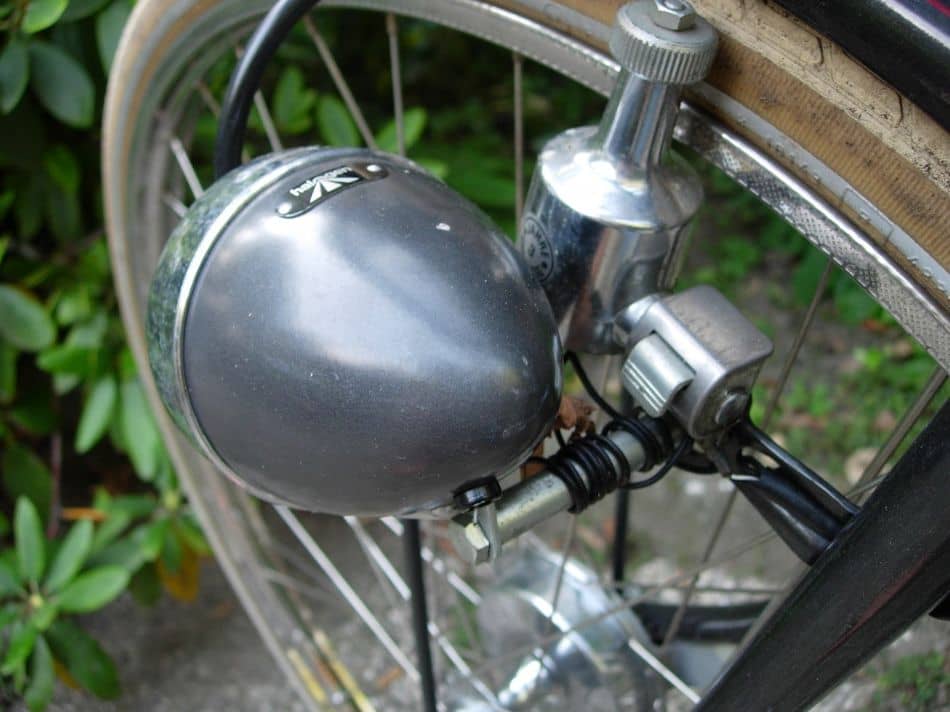
Final Thoughts on Dynamo Lights
Dynamo lights aren’t just nostalgic, retro-cool lights. They are great choices for specific situations. If you are a daily commuter, especially one who rides after dark, a dynamo light is a great choice because it is always on. If you live in an area where bike lights are required for riding, you may want the freedom of a dynamo because you don’t have to worry about charging and attaching your light for every ride.
On the other hand, if you are a racer and are worried about extra drag or weight, you might prefer the size and weight of a small battery-powered light.
If you liked this article, you might also like the following:
- The Best Bike Saddle Bags for Commute and Tours (2023)
- Best Electric Scooters for Commuting: Our Top 7 Picks for 2023
- How to Measure Bike Wheel Size: An Ultimate Guide (2023)
Frequently Asked Questions
In 1923, Robert Bosch produced what we now think of as a dynamo bike light. It was a small front light powered by a dynamo placed just behind the fork on the bike’s front wheel.
A dynamo hub on a bicycle is actually AC, while standard dynamos (that you don’t find on bicycles) are actually direct current.
Most bicycle dynamos produce 6 volts of electricity, although some can be made that produce up to 12.
Most bike lights on the market range from 250 to 2000 lumens. The brighter the light, the shorter the run time will be. If you are riding at night, you should consider using a light with at least 1000 lumens to see well and be seen.
Dynamo lights and hub sets start at about $120, not including installation. A full dynamo build, including the hub, lights, and wheel, will cost anywhere from $200 to $800, depending on the system quality you buy.
A dynamo hub system will add around 1.5 to 2 pounds to the weight of your bike. Of course, you might not want to do that to your aero or race bike, but you might not notice the difference on your daily commuter or winter bike.

Amanda Whittington is an expert writer, impassioned cyclist, and musician. Coming from a diverse educational background, Amanda discovered a deep-rooted passion for encouraging others through her love of all things cycling, writing, and inspiring hope.
You’ll likely find Amanda pouring over bike specs, comparing the hottest cycling tech, and sporting the latest jerseys while juggling the demands of her editorial calendar, training schedule, tiny homestead, and 6 busy kids.
She spends her free time absorbed in her own gardening and fitness, cycling, and reading, all while encouraging adoption and foster care, championing the underdog, and of course, working with her chickens and goats.

